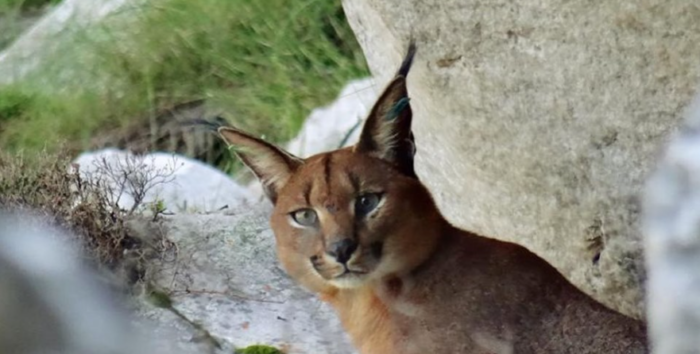The Noordhoek Environmental Action Group together with the Urban Caracal Project have noted some disturbing and tragic occurrences surrounding the caracal population in Noordhoek.
Dr. Laurel E.K. Serieys from the Urban Caracal Project has been concerned about caracals who are currently living and breeding in Noordhoek, as recent reports have shown their numbers have been reducing not only due to cars on the mountain roads, a big hazard, but also due to nefarious individuals who have been hunting them.
Rangers recently released a tagged caracal from a snare set by unknown individuals in the wetlands in Noordhoek. While in the area, the rangers also came across the horrific discovery of the skin of a young caracal kitten.
Serieys says, “The last couple weeks were indeed bad for caracals in the Noordhoek area and worse than even what you thought. Yes, a caracal was caught in a snare in the Noordhoek wetlands – it was a tagged cat, Spitfire, who is often reportedly seen by horse riders. She was luckily freed and seemed to sustain no injuries. However, in the process of scouting around the area, rangers did discover the skin of a juvenile- possibly even Spitfire’s offspring, that was skinned.”
Dr Serieys says the traps are set by hunters who are specifically looking for food.
“The trap was set by a bushmeat poacher- he is most likely just looking for a source of food and was not targeting the caracal. I suppose the skin was left because the person didn’t want to eat it. That it’s a caracal kitten hits you and I hard, but to someone looking for food, it was just another food source,” said Serieys.
As if these heinous incidents weren’t enough, two caracals were also recently killed by vehicles on Ou Kaapse Weg, and one caracal was reported to have been killed on the road in Glencairn.
“Last week, a caracal kitten – very young – only a few months old – was hit on Ou Kaapse and killed. We recovered the carcass. The following day there was a reported roadkill caracal on Glencairn, though by time I got there in the morning, it had already been taken (if anyone knows who picked it up or has a pic of the roadkill, I’d appreciate getting the info),” says Serieys. “People have reported roadkill genets as caracals in the past, so without seeing it, I can’t 100% confirm, but it’s possible. That same morning, another caracal was hit in the same place on Ou Kaapse as the kitten. It was an adult female that was nursing. She was probably the mother of the kitten killed, and that also means if she had other kittens, those are likely dead by now too.”
These two organisations are working towards making the Noordhoek area safer for the caracal population, but rely too on the help of concerned individuals who report incidents and pay attention to the environment they live in.
Locals are also being reminded to be especially cautious when travelling on mountain roads as this is the domain of wild animals and they could be crossing the roads at any time. The Urban Caracal Project is also warning local communities about the dangers of poisons meant for pests.
“People should be cautious as they are driving those mountain roads. Generally I would recommend for Noordhoek to push for less use of anticoagulant rodenticides! The poison bait boxes that are everywhere- sun valley mall and the Farm Village- those boxes likely contain poisons that can and do harm the caracal population as well as other wildlife species,” says Serieys.
Locals can report any caracal-related incidents to 079 837 8814.
Also Read:
Caracals could face extinction.
Rat poisons harming wild Cape animals.
Picture: The Urban Caracal Project






